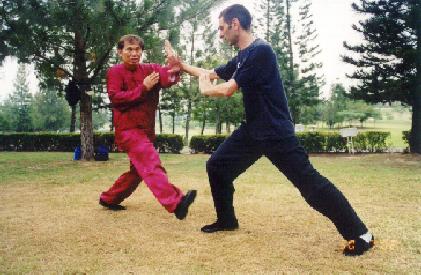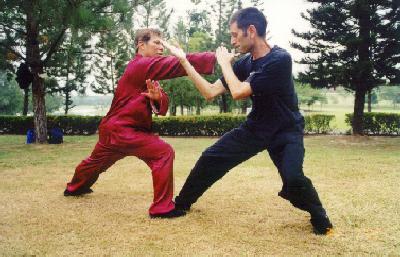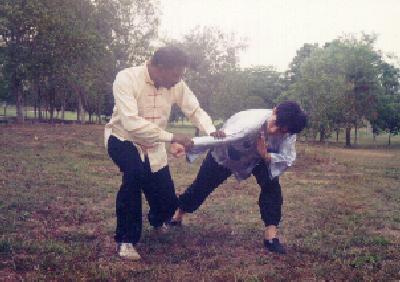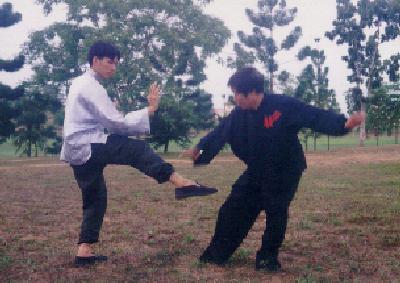September 2002 (Part 2)
SELECTION OF QUESTIONS AND ANSWERS

Sifu Wong and Javier Galve engaged in sparring during the Special Taijiquan Course in July 2002 in Malaysia
Question 1
What is the difference between Tai Chi Chuan and Wushu? Which you would recommend for a lady to learn?
— Lim, Malaysia
Answer
Traditional Chinese martial arts have been so debased today that Chinese martial art terms like “Tai Chi Chuan” and “Wushu” often have lost their original meaning. “Tai Chi Chuan” (or “Taijiquan” in Romanized Chinese) is actually an internal martial art, but today it is usually practised as some sort of gentle dance-like exercise. “Wushu” is the Chinese term for martial art, but today it is practised as gymnastics.
Tai Chi Chuan is one of many forms of wushu. Shaolin Kungfu and Baguazhang are two other forms of wushu. Tai Chi Chuan, Shaolin Kungfu and Baguazhang can be called Tai Chi Wushu, Shaolin Wushu and Bagua Wushu.
About 25 years ago, the present Chinese government standardized numerous styles of traditioanl Chinese wushu, or martial arts, into seven modernized wushu categories. In other words, in the past in China there were countless different styles of martial arts, such as Tai Chi Chaun, Shaolin Kungfu, Baguazhang, Hsing Yi Kungfu, Praying Mantis Kungfu, Chaquan, Huaquan, Mizhong yi, Hoong Ka Kungfu, Mok Ka Kungfu, Wing Choon Kungfu and so on.
After the standardization, there are only seven modernized wushu styles, namely Changquan (Long Fist), Nanquan (Southern Fist), Taijiquan (Tai Chi Chuan), Daoshu (Knife Technique), Jianshu (Sword Technique), Gunshu (Staff Technique) and Chiangshu (Spear Technique). But modernized wushu, despite its meaning, is never practised as martial art; it is practised as gymnastics or sports.
With this background knowledge, you would realize that your questions are invalid. Irrespective of whether you refer to Tai Chi Chuan and wushu in their traditional or modern context, the former is a subset, and the latter is the whole set. It is like asking the difference between an orange and fruit, and which one should be recommended to a lady.
Nevertheless, words are not always used according to their rigid meanings. In current usage, when one mentions Tai Chi Chuan, he often refers to its dance-like version although conceptually it is a martial art; and when one mentions wushu, he often refers to Changquan although it is only one of the seven modernized wushu categories.
Whether I would recommend dance-like Tai Chi Chuan or wushu, which is quite acrobatic, to a lady would depend on various factors. If all other considerations were equal, if the lady is elderly I would recommend dance-like Tai Chi Chuan, if she is young I would recommend wushu as Changquan.
Question 2
I study with two different masters, one teaches me Southern Shaolin from the Fukien Temple, the other teaches me Taijiquan and Hsing-I. Do you think I should learn all three at once or stick with one style to master it?
— Holger, England
Answer
Generally it is better to stick with one style to master it. Nevertheless, at the early stages, you may learn a few styles for comparison, then choose one style to master.

Sifu Wong executes a finger thrust and Javier responds with a “peng” techniques during a Taijiquan sparring session
Question 3
Do you know anything about the tiger-crane combination system which emphasizes sticking to the opponent until an opportunity arises to strike, because I always wonder whether is it not Wing Choon instead of Hoong Ka.
Answer
The tiger-crane system is typical of Hoong Ka (Hung Gar) Kungfu, but its exponents as well as Wing Choon (Wing Chun) exponents may or may not stick to their opponents. Indeed, if an opponent is physically bigger or stronger, or if he frequently uses gripping techniques, it would be disadvantageous for a Wing Choon exponent to stick to him.
One may have the mistaken concept that Wing Choon exponents stick to their opponents because “Chi Sau” or “Sticking Hands” is a crucial method in combat training. An important combat tactic in Wing Choon Kungfu is “loi lau huei soong, leik sau cheit joong”, which means that when the opponent attacks, we keep contact with his attacking hand, when he retreats his attacking hand, we follow with a counter-attack still maintaining contact. This is the first part of the tactic, namely “loi lau huei soong”, and it advocates sticking with the opponent.
But if contact is broken off, a Wing Choon exponent would not attempt to re-establish contact. Instead he would strike straight and fast at the opponent. This is the second part of the tactic, namely “leik sau cheit joong”.
A similar method to “Chi Sau”, but is comparatively “harder”, is also practised in Hoong Ka Kungfu although it is not so much emphasized as in Wing Choon Kungfu. It is called “Men Kiew” or “Asking Bridge”. As in “Chi Sau”, in “Men Kiew” two exponents practise various attacking and defending movements with their forearms in contact.
The kungfu style where sticking with the opponent is most emphasized is Taijiquan, even when the opponent is physically bigger and stronger. Why is it that in Wing Choon Kungfu the exponent avoids direct contact with the opponent when the latter is bigger or stronger, but in Taijiquan the exponent still sticks to him? This is because Wing Choon Kungfu and Taijiquan employ different principles. Wing Choon Kungfu uses leverage and straight attacks, whereas Taijiquan uses circular movements and internal force.
Question 4
My master's lineage goes back to Tee Eng Choon and Hung Ee Kan who married and created a combination of the best of their styles -- white crane and tiger style.
Answer
A big problem with Chinese names is that they may be pronounced in different dialects and thus spelt differently. In Cantonese pronounciation, the dialect usually used in Hoong Ka Kungfu, “Tee Eng Choon” and “Hong Ee Kan” are “Fong Wing Choon” and “Hoong Hei Khoon”.
In fact it is precisely for the reason of avoiding possible mis-pronuciation that I usually use the spelling “Hoong Ka” and “Wing Choon”, instead of “Hung Gar” and “Wing Chun” as used by many people. It is easy for those not familar with Cantonese to mis-pronounce “Hung” to rhyme with “rung”, and “Chun” to sound like “chan”.
Fong Wing Choon was a female kungfu master in Fujian Province of south China famous for her White Crane Kungfu. In the Fujian dialect, “Fong Wing Choon” is pronounced as “Fang Eng Choon”.
Hoong Hei Khoon was a Southern Shaolin master famous for the tiger style. He was the first patrairch of Hoong Ka Kungfu. He married Fong Cheit Leong, who was an expert of White Crane Kungfu. Husband and wife combined their styles into the Tiger-Crane style, which is characteristic of Hoong Ka Kungfu today.
Some accounts mention that Hoong Hei Khoon married Fong Wing Choon. It was possible that Fong Cheit Leong and Fong Wing Choon were the same person. “Cheit Leong” means “seventh lady”. It was possible that Fong Wing Choon was so called because she was the seventh child in her family.

Mogan uses a tiger pattern to break or dislocate Tai's elbow in a Shaolin sparring session
Question 5
I found a real treasure, a master in Hsing Yi and Taijiquan. He was four times champion in China in Pushing Hands in Hsing Yi with 35 years of experience in this art, and 25 years in Taijiquan and Baguazhang. He also practises Chinese herbal medicine and treats people with Chinese massage, accupuncture and patent medicine.
The good thing with this master is that he has one to one lessons which make it very effective to learn the arts. The only problem with him is that he speaks just Chinese, so his daughter has to help us in difficult situations. Do you think that he is a real master with this kind of history and knowledge? It is not that I don't respect him but you said it was worth it to search for the right master.
Answer
The question is not whether he is a real master but whether you are a deserving student, or whether you are human. You said you respected him, but have you ever thought how disappointed and hurt he would be if he knew that despite all he had done for you, you doubted him just because he could not teach you in English. What do you expect him to do? Take lessons in English so that he can teach you?
Yet, even if he is a real master, he may or may not be a good teacher. But he has been very kind to you, and you have been unreasonable. In kungfu we do not just learn how to fight, or worse still to perform to please spectators. We learn and cherish many ideals, one of which is to repay kindness with kindness, not to think how much we can get out from this old man while he is still available. Your master has treated you like his son. The least you can do is to be kind to him.
Question 6
I have noticed that lots of books, including your wonderful Chi Kung book, have pictures of meridians What is the purpose of knowing where the channels are if the channeling of chi is achieved with a thought of where the chi should go and not what path it should follow. Forgive me if I misunderstood the theory because I am not able to perform the above mentioned feat yet.
— Rikus, South Africa
Answer
The main purpose of illustrating the network of meridians is to let people have an idea where the meridians are and how chi or vital energy flows. One must, however, remember that the diagrams showing the meridians are much simplified.
As you have implied, not many people have the skill to use his thought in channeling energy to where he wishes it to flow. Even if they have this skill, having a clear idea of the energy network, albeit in a much simplified form, is very useful.
The diagrams are very helpful to students of traditional Chinese medicine. Acupuncture students need to know where the meridians and their energy points are in order to insert acupuncture needles correctly and systematically. Even if they can channel energy flow using their thought, they may know only one line of energy flow but not the holistic network. Herbalists need to know which energy paths Chinese herbs tend to take inside their patients' body, and the diagrams of meridians will help them to plan their therapeutic approaches better.
Kungfu masters will also find the diagrams useful. Having a clear idea of the energy network of his opponent, will enable the master to attain maximum result with minimum force, especially in such advanced arts like “dian xue” (“dim mark” in Cantonese) and “qin-na”.
Actually a knowledge of the energy network, simplified in diagrams in books, can benefit anybody. If Western surgeons make good use of this knowledge, they may not have to cut open a patient first to see if there is anything wrong with his heart or liver, for example. They can have a fairly good idea of the internal organs by looking at the patient's surface, and in the case of heart and liver by looking at his mouth and eyes. In a more daily situation, if a person finds his knees constantly weak, he would take heed whether he is having excessive sex. The knowledge is gleaned from an understanding of the energy system.

Tai Chee Yong exercutes an organ-seeking kick at Sifu Wong's groin; Sifu Wong retreats his front leg and is about to chop at Tai's leg. Both exponents here use crane patterns.
Question 7
How did the great masters of the past know where the channels are if we are not able to see them?
Answer
You may not be able to see them, but great masters could. Some of my students saw their own meridians. It is for illustration that these meridians are mentioned in books. The medridan system is very important in Chinese medicine.
For the sake of other readers, it would be helpful to point out that meridians are also known as channels. Meridians or channels are the pathways of energy flow inside a person's body.
Meridians usually flow deep inside the body, but there are numerous point on the surface of the body where these meridians may be reached. These points are called energy points or acu-points.
A master or a trained person can identify these energy points well. For example, by pressing on these points of a person, the master can cause him pain or numbness. By linking these points he has a clear idea where the respective meridian is. If the master moves his palm over the meridian, he can feel a resonance from the meridian.
If someone were to intellectualize, it is likely that he would reason the energy points were discovered first, possibly by trials and errors over many centuries, and by linking these points the meridians were then noted. Actually the reverse was the case. The network of meridians was discovered in total first, the energy points were discovered later.
Question 8
I do “Lifting the Sky” and an exercise from another book from Sifu Doc Fai Wong (“Tai Chi Chuan's Internal Secrets”, Unique Publications) called Fen Yuan. I immediately felt the heavy, warm feeling in my arms and hands when I started both of the above mentioned exercises. When I held my hands about an inch from each other it felt like there was a pressure pushing my hands apart.
But after about five months of daily practice the feeling started to change. It now feels like my hands are attracted to each other like two magnets. This is probably a stupid question, but why did this happen and what did it imply if it implied anything?
Answer
You developed some energy at your palms after performing “Lifting the Sky” or “Fen Yuan”. When you placed the two palms near each other, the energy pushed the two palms apart.
Five months later your energy increased and flowed well along your arms. When you placed your palms near each other, the energy from one arm flowed to the other arm through the palms, thus pulling them together.
Question 9
I am currently saving money to attend your chi kung course. I imagine the process of learning chi kung to be the best thing one can experience.
Answer
When a sincere student had no money and wanted to learn from me, I was often tempted to teach him free. Indeed I usually did that in my earlier days. But years of experience have taught me that if I did that, I would be doing the sincere student a dis-service!
It would be worse in the case of cancer patients. If a cancer patient had no money to pay me his fee, I would not teach him. Certainly I would appear cruel. But I know very well that if I taught him free, I might spoil his chance of recovering from his dreadful disease. Many people may not believe it, but it is true.
If a person suffering from cancer did not feel compulsion enough to raise US$1000 and some other expenses to come to Malaysia to learn from me, it shows that he does not really believe practicing chi kung can overcome his cancer. It would then better for him to seek treatment elsewhere where he has confidence.
Many of my students had no money. But they worked and saved to attend my intensive courses, and these students always did very well. I am very proud of them. I believe they will be future masters who will preserve the Shaolin arts.
Practising genuine high level chi kung is one of the best things everyone can do. This is not a rhetoric statement. Chi kung not only gives you good health and vitality but also expands your mind and fills you with spiritual joy.
